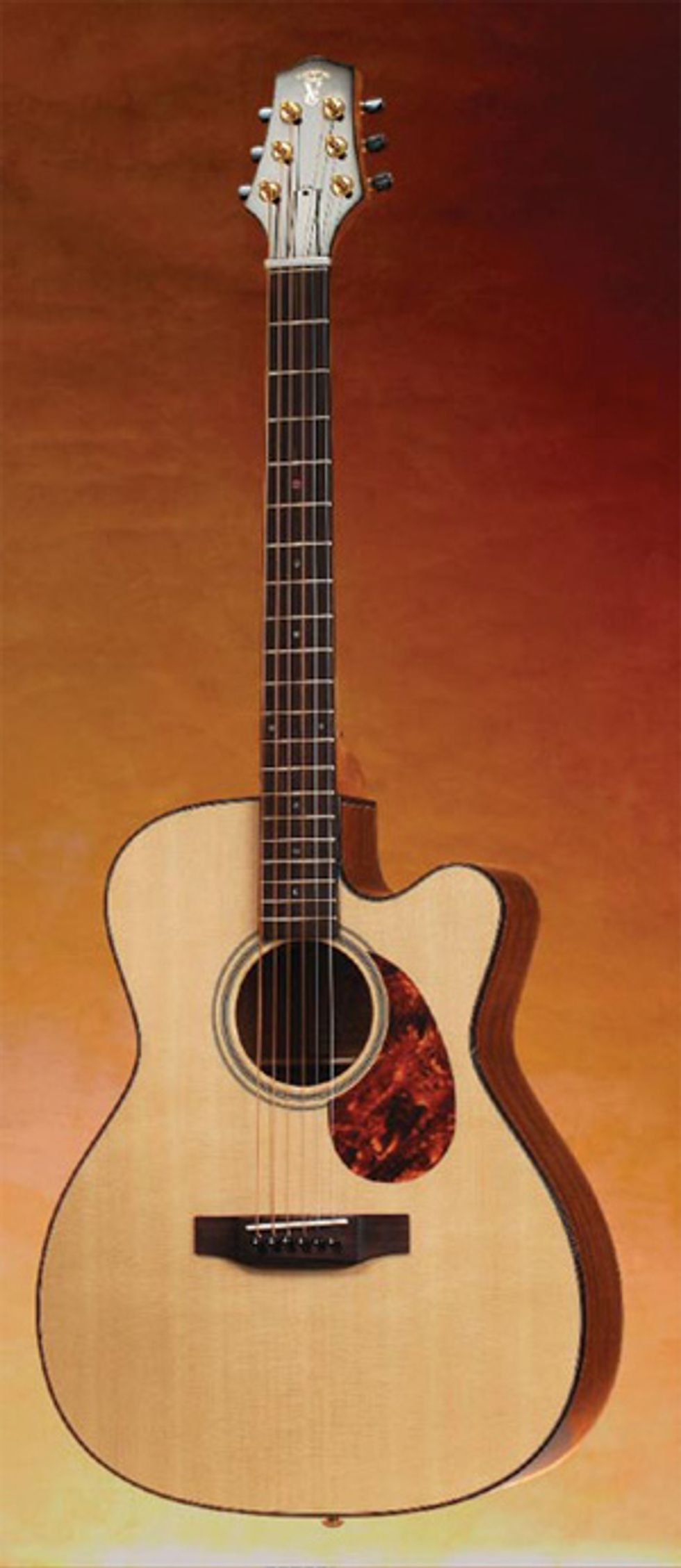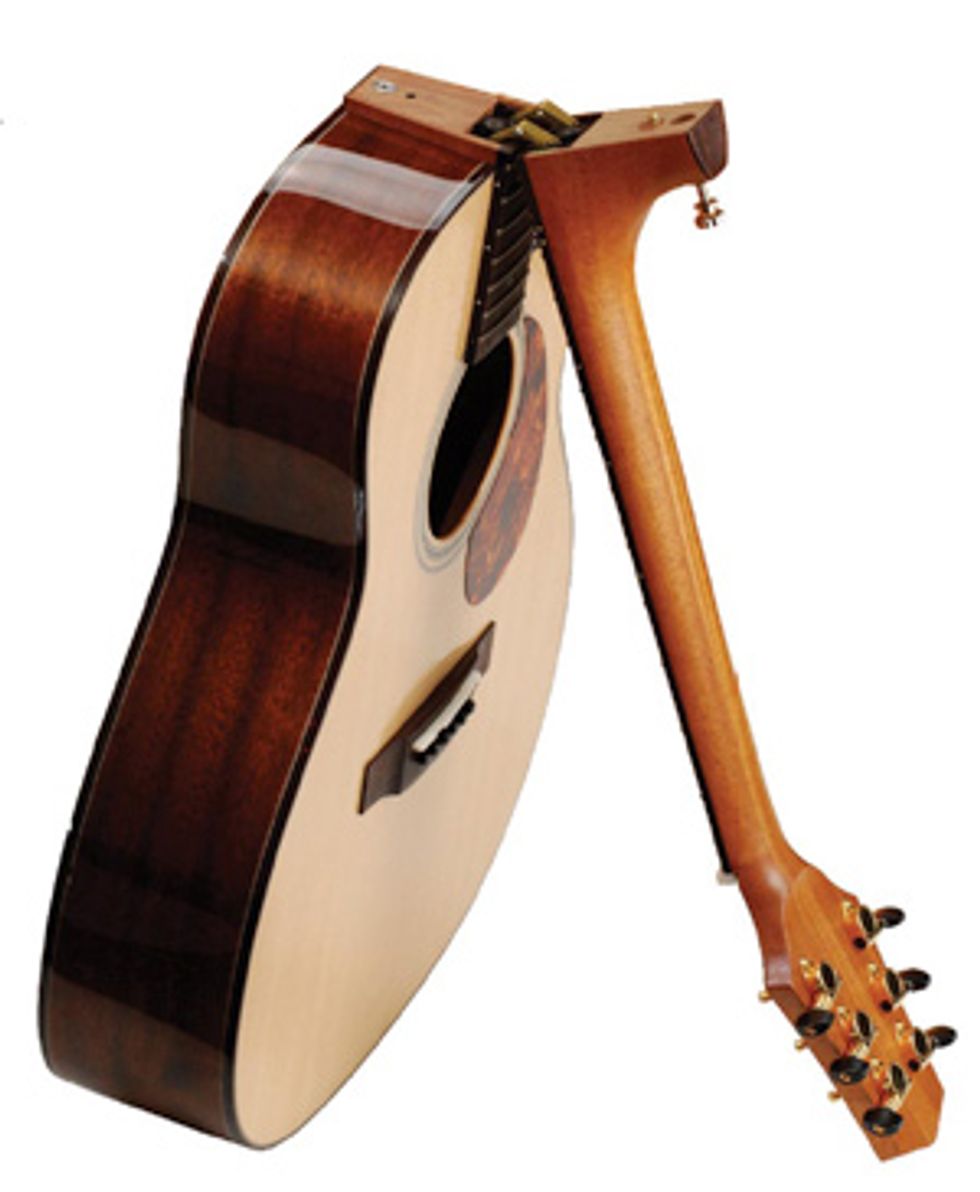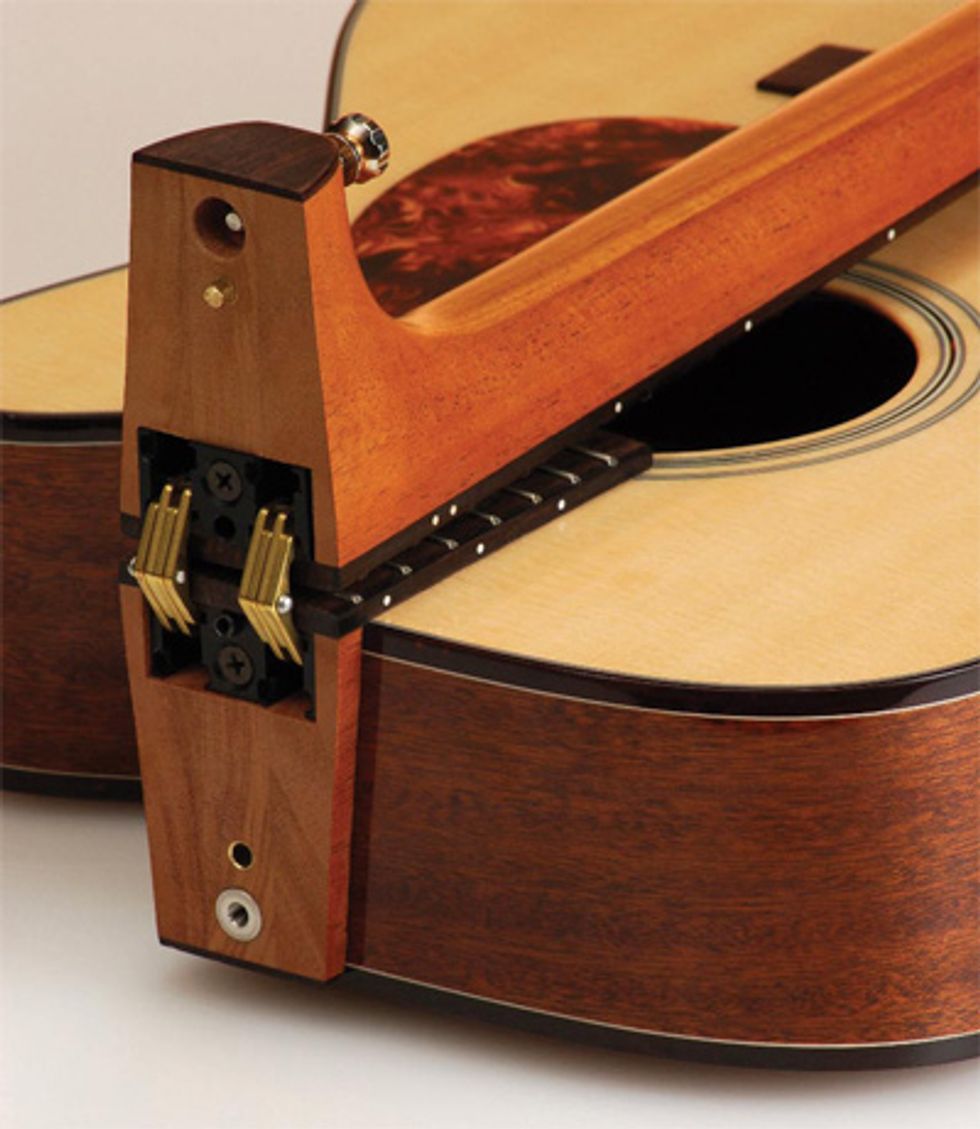The Voyage-Air is a travel guitar that defies reason with its tone and stability.
 |
|
| Download Example 1 Flatpicked Standard Tuning |
|
| Download Example 2 Fingerstyle Standard Tuning |
|
| Download Example 3 Fingerstyle DADGAD |
|
| Download Example 4 DADGAD Capo 5 |
|
| Video Review: Click for larger video (opens in new window). |
|
It’s considered a “travel guitar,” and it truly is a remarkably portable instrument; however, that label does it a disservice, because honestly, it’s a damn nice guitar. It just happens to have a nifty set of hinges at the heel that allow the neck to fold over on the top, making it far more compact and transport friendly. The Voyage-air is already revolutionizing the world of travel for many world-class professional guitarists, such as Thom Bresh and Jody Maphis, who won’t leave home without their Voyage-air guitars. There’s also a growing group of Nashville singer-songwriters who have adopted this guitar as the essential new tool that allows them to work anywhere without sacrificing what a full-bodied guitar brings to their craft. The case (included) is ultra-light and high-impact, and can be worn like a backpack. There’s enough storage inside to accommodate the ultimate songwriting kit: the guitar, a laptop, and a digital recorder.
I decided to call Harvey Leach and learn a little more about how this unique instrument came into being. He said it began in the usual way: a guitarist asked him if he could make a guitar with a removable neck for easier transport, and having made about 350 guitars with bolt-on necks, he thought it would be possible. However, after some experimentation, he came to the conclusion that the process of removing a neck from a guitar is daunting enough for somebody who does it all the time, let alone somebody who isn’t a trained luthier. He scrapped that idea and hit upon the notion of a hinged neck. “In making it simpler for the user I made it much more difficult for me, but the goal is always to make it as functional as possible for the player.”
The production team now includes Lance McCollum and Hank Mauel, both builders of highly prized boutique instruments. They, along with Leach, are the current “custom shop” for Voyage-air. If you want something other than what the factory offers, they will build whatever you want, and it’ll cost about what a custom handmade Leach, McCollum or Mauel guitar will cost, which is dependent on materials and ornamentation.
In Good Hands
One of the first models ended up in the hands of Thom Bresh, who wanted Leach to send him one without any preface. “He wanted to play with it—see how intuitive it really was,” Leach said. The first time he saw Bresh playing his guitar was at a NAMM show. “He was sitting at this booth playing, and there were a bunch of people around, so he stopped in the middle of a song and said, ‘Watch this!’ and proceeded to unscrew the bolt without de-tuning the guitar. I was horrified—everybody knows if you take all the tension off a guitar all at once it’s gonna poke a big hole in the ozone layer or something—but Bresh just went for it, and the crowd was standing there dumbfounded when they saw it fold. Then he said, ‘Oh, that’s not all, hang on!’ and he tightened it back up and just started playing. I had no idea it would stay in tune. I hadn’t talked to him about de-tuning it; it hadn’t even occurred to me that he’d do it any other way. That just shocked me. Sometimes the guys who have all the training get so caught up in what they know is supposed to be right that it takes somebody who has no idea about all that to show them how something really works. That was quite an epiphany.”
In a phone conversation, Bresh made a point that hadn’t occurred to me; when you’re flying with a guitar and you have to walk for long distances through airports, guitar cases—especially those sturdy enough for air travel—get extremely heavy and your hands stiffen up and cramp, making it difficult to go straight from the airport to the stage. “This guitar is—period, the end—the greatest guitar when you have to fly,” he said. “I don’t have to worry about turning it over to somebody to find someplace to put it—I’ve just got it with me. I put it on my back and walk wherever I need to go, and it’s so light I almost forget it’s there.” Bresh tends to travel with an arsenal, and is really excited about how many more Voyage-air guitars fit into his trunk than conventional guitars. For many working musicians, the price of a tank of gasoline has a dramatic impact on income and expenses; to be able to fit everything we need into a smaller and more economical vehicle can mean the difference between profit and loss. Jody Maphis may have put it best: “Harvey’s whole thing is, ‘If it’s not a great guitar, what’s the point?’ For traveling there’s never been anything like it, but when you get to the gig and you need to use it, it’s exactly what it needs to be.”
The Voyage-Air Unfolded
 I received for review the VAOM-1C, a smallbodied
mahogany model. The playing experience
with this guitar is pretty much exactly like
playing any other fine factory-made guitar. It’s
extremely comfortable to hold, with a body
depth of 3-3/8” at the neck and 4-1/8” at the
end pin. The fit and finish are top notch; the
tone is rich and satisfying, and it plays very
much like a Martin or Taylor in the same price
range. Just looking at it, there’s no way in the
world you could tell there is anything “different”
about it—and you can’t by playing it,
either. The gold-plated “strap-bolt” does double
duty as a slightly oversized strap button,
so unless you are paying really close attention,
you’d never, ever know it wasn’t a conventional
guitar. The premium mini Schaller-style tuners
are gold plated with black buttons. With
simple tortoise binding and a black and white
purfling rosette, it’s lean and clean, simple and
very attractive.
I received for review the VAOM-1C, a smallbodied
mahogany model. The playing experience
with this guitar is pretty much exactly like
playing any other fine factory-made guitar. It’s
extremely comfortable to hold, with a body
depth of 3-3/8” at the neck and 4-1/8” at the
end pin. The fit and finish are top notch; the
tone is rich and satisfying, and it plays very
much like a Martin or Taylor in the same price
range. Just looking at it, there’s no way in the
world you could tell there is anything “different”
about it—and you can’t by playing it,
either. The gold-plated “strap-bolt” does double
duty as a slightly oversized strap button,
so unless you are paying really close attention,
you’d never, ever know it wasn’t a conventional
guitar. The premium mini Schaller-style tuners
are gold plated with black buttons. With
simple tortoise binding and a black and white
purfling rosette, it’s lean and clean, simple and
very attractive.Go to Page 2 for more the rest of the review and the rating...
The hinge mechanism is finely made; the strapbolt on the heel easily loosens, taking the tension down slightly, so that when you do the fold over the impact is somewhat diminished. The hinge itself looks like something that would move a robotic arm—it’s a very fluid motion, clean and smooth. Taking it back up again is a little tricky the first couple times, but once you get the hang of it, it is a lot easier. You have to hold it pretty firmly to allow the bolt to meet the opening, but it catches quickly and tightens easily. You don’t have to torque it down with an air wrench for it to be secure—just tighten it until you can’t move it with your fingers anymore and it’s good to go. Jody Maphis is a “power-user;” he gigs with his Voyage-air on a nightly basis, folding and unfolding it several times throughout a single night, and says the guitar is unbelievably durable and hasn’t given him a minute of trouble in all the years he’s had it.

Just because I’m a skeptic, I folded and unfolded it a few times back and forth. The guitar eventually went out of tune after four folds, but it only needed a little tweaking to get back into tune again. I’ve owned guitars in the past that wouldn’t stay in tune for a day without being folded, so it’s not really a mark against the Voyage-air that it de-tunes after you fold it a few times. In fact, it would scare me a bit if it didn’t.
The action on the guitar I got from the factory was set a little high for my taste, however a zero-fret and compensated saddle make additional setup pretty straight forward. As it sits, it’s very playable and frets perfectly clean all the way up with no intonation issues at all. The seam where the hinge is hidden is about 3/8” from where the heel meets the body, and you can barely feel it when you’re fretting up around the cutaway. Nut widths at this point are standardized—1-11/16” for the dreadnaughts and 1-3/4” for the OM—but Leach says if there is enough demand, they may consider offering some factory alternatives in the future. The Corian nut is very interesting—it’s a “no release” design, so when you release the screw and fold the guitar over, the strings stay in place at the headstock, and you can simply roll them neatly out of the way into the soundhole. The zero-fret works beautifully to keep the strings at the proper height, while the no-release nut locks them into place for the folding process.
The factory can install a pickup for you if desired; their standard is the L.R. Baggs Active Element, but any pickup that attaches to the underside of the top (such as a Baggs I-Beam, a B-Band or K&K) will work just fine.
The Final Mojo
If you travel at all with your guitar, many of the experiences related above will ring very true to you. Personally, I love that there is enough room in the case for cables, mics, DI/effects pedals and a small guitar stand, and there’s still room in the extra compartment for my laptop and recorder—and I can throw it on my back and carry my amp in one hand and a bag full of merch in the other. The more compact and self-contained we artists can be, the easier our lives get and the fewer expenses we have. It’s a beautiful equation, and the bonus points are that this is a fantastically good guitar that sounds, plays and feels like one of the best factory made guitars out there. At a retail price of $1695, the value is through the roof, making this a real no-brainer.
Buy if...
you travel at all and you need a very real guitar.
Skip if...
you never make it past your front porch and you’re completely in love with all the guitars you already own.
Rating...

|
MSRP $1695 - Voyage-Air - voyageairguitar.com
|


